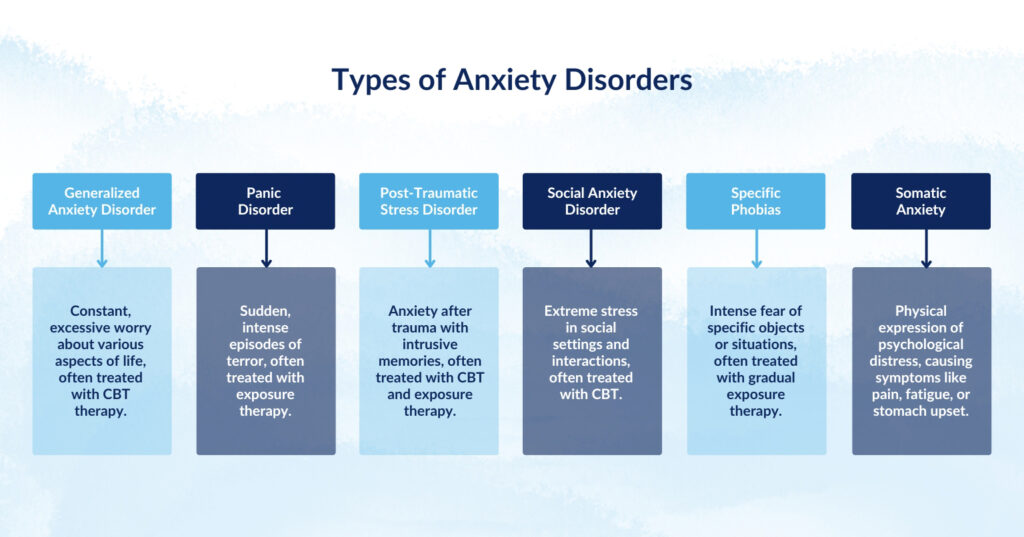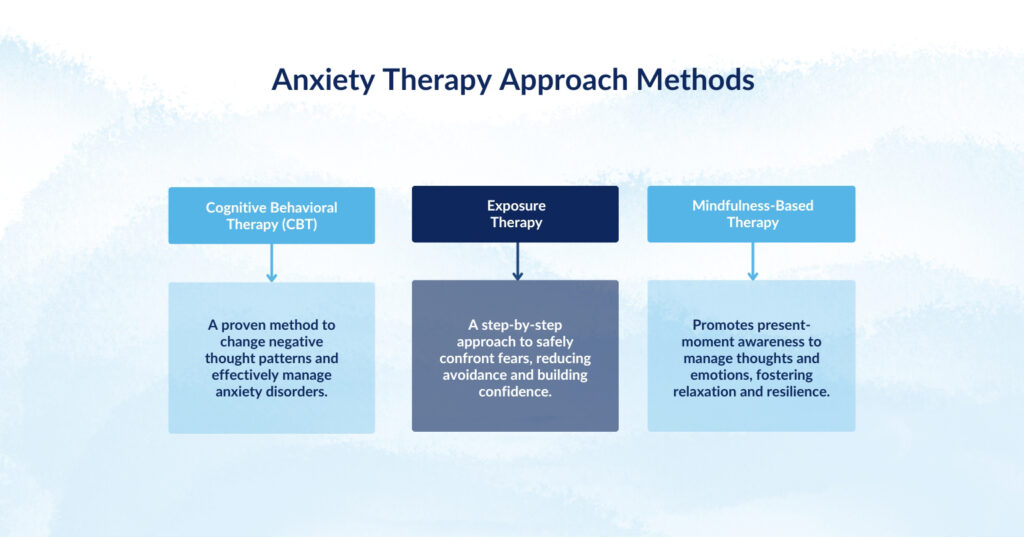
Imagine waking up every day with a sense of dread. Your heart races, and your mind is filled with worry. For millions, this is their reality. But here’s the truth: you’re not alone, and there is hope.
Anxiety is a common and treatable condition. It goes beyond everyday worry. It can take many forms, like generalized anxiety disorder (GAD) or social anxiety. The good news is that therapy offers a way to recover, teaching you to manage and overcome anxiety.
Cognitive behavioral therapy (CBT) and exposure therapy are powerful tools. They’ve helped many people take back their lives from anxiety. These treatments focus on changing negative thoughts and facing fears. Through therapy, you can learn to challenge anxiety and build resilience for a brighter future.
Seeking help is a sign of strength, not weakness. It takes courage to acknowledge your struggles and seek support. At Pillars of Hope Counseling, we understand the challenges of anxiety. We’re here to support you on your journey to healing. Angelie offers personalized care tailored to your needs.
Whether you’re dealing with persistent worry, panic attacks, or social fears, you don’t have to face anxiety alone. Therapy can truly change lives by giving you the tools and direction for healing and resilience. It’s a collaborative process that empowers you to take control of your thoughts, emotions, and behaviors, one step at a time.
If you’re ready to break free from anxiety, take that first courageous step. Reach out to Pillars of Hope Counseling to start your journey towards a life of peace, confidence, and fulfillment. You deserve to thrive, and we’re here to support you every step of the way.
Key Takeaways
- Anxiety is a common and treatable condition that affects millions of people.
- Therapy, particularly Cognitive Behavioral Therapy (CBT), Dialectical Behavioral Therapy (DBT), and exposure therapy, offers effective strategies for managing and overcoming anxiety.
- Seeking help is a sign of strength, and therapy can genuinely transform lives.
- Pillars of Hope Counseling provides specialized anxiety treatment with compassionate therapists and personalized care.
- Take the first step towards healing by reaching out for support and beginning your journey to a brighter future.
Introduction to Anxiety Therapy
Best Practices for Anxiety Treatment | Cognitive Behavioral Therapy
Anxiety is a common condition that affects many people worldwide. It’s normal to feel anxious in stressful situations. But when it becomes too much, it can really affect our daily lives. Understanding anxiety and its symptoms is the first step to finding relief and recovery.
Anxiety disorders are very common in the United States, affecting about 40 million adults. Yet, only 36.9% of those affected get treatment. Getting professional help, like therapy, can offer the tools and emotional support for anxiety needed to manage symptoms and improve well-being.
Beyond Everyday Worry
Everyone worries sometimes, but anxiety disorders are different. They involve persistent and excessive fear or worry that gets in the way of daily activities. Anxiety can show up in many ways, including:
- Cognitive Symptoms: Racing thoughts, trouble concentrating, and constant worrying
- Physical Symptoms: Fast heartbeat, sweating, trembling, and feeling tired
- Behavioral Symptoms: Avoiding situations that cause anxiety, feeling restless, and being irritable
It’s important to recognize these symptoms to find the right anxiety treatment options and start the journey to recovery.
Anxiety Therapy as a Path to Recovery
Therapy is a proven way to manage anxiety disorders. Cognitive Behavioral Therapy (CBT) is a common method. It helps people change negative thought patterns that lead to anxiety. Through CBT, individuals learn strategies to face their fears, leading to anxiety relief and better functioning.
“Therapy provides a safe and supportive space to explore the roots of anxiety and develop personalized strategies for managing symptoms and reclaiming a sense of peace and control in one’s life.”
Other therapies, like Dialectical Behavior Therapy (DBT) and Exposure Therapy, can also help. Working with a skilled therapist, people can find the best anxiety treatment options for their needs. This leads to lasting anxiety recovery.
Exploring Different Types of Anxiety Disorders

Anxiety disorders are more than just worries or fears. They are complex mental health conditions that can greatly affect daily life. Nearly one-third of people may experience some form of anxiety disorder at some point. It’s important to understand the unique challenges each type presents.
This list is not exhaustive but highlights common anxiety disorders. Other types include Somatic Anxiety, Obsessive-Compulsive Disorder (OCD), Separation Anxiety Disorder, and Selective Mutism.
Generalized Anxiety Disorder (GAD)
Generalized Anxiety Disorder (GAD) is marked by constant, excessive worry about life’s aspects. It affects about 3-5% of adults in the U.S., causing intense worry over many situations. Symptoms include restlessness, fatigue, trouble concentrating, irritability, muscle tension, and sleep issues. GAD treatment often includes psychotherapy like Cognitive Behavioral Therapy (CBT) and medication to manage symptoms.
Panic Disorder
Panic Disorder affects 2-3% of people in the U.S., causing sudden episodes of terror without warning. Panic attacks can be triggered by many things, like caffeine, social events, stress, traumatic experiences, and lack of sleep. Therapy for panic attacks may include exposure therapy and medication to regulate brain chemistry and reduce symptoms.
Post-Traumatic Stress Disorder (PTSD)
PTSD affects 3-6% of adults in the U.S., often emerging after traumatic events such as accidents, natural disasters, or combat experiences. This anxiety disorder goes beyond fleeting stress, manifesting through intrusive memories, nightmares, heightened vigilance, and emotional numbness. Effective treatment, such as trauma-focused cognitive behavioral therapy (CBT) and exposure therapy, provides a pathway to healing.
Social Anxiety Disorder (Social Phobia)
Social Anxiety Disorder, also known as Social Phobia, impacts about 7-10% of the U.S. population. It causes extreme stress in social interactions, leading people to avoid social events or feel constantly judged. Treating social phobia often involves CBT and medication like SSRIs to manage symptoms.
Specific Phobias
Specific Phobias affect 8%-12% of people in the U.S., causing intense fear or dread triggered by specific objects or situations. These irrational fears can greatly interfere with daily life. Phobia therapy typically involves gradual exposure to the feared object or situation, helping individuals build coping skills and reduce anxiety over time.
Somatic Anxiety
Somatic Anxiety manifests as physical symptoms like pain, fatigue, or stomach upset caused by psychological distress. Affecting 5% to 7% of adults, it’s linked to heightened anxiety about these symptoms, often disrupting daily life. Treatment includes CBT, mindfulness, and relaxation techniques to address both mental and physical aspects.
Understanding each disorder’s unique features is key to developing personalized treatment plans. These plans may include therapy, medication, or a combination of both.
How Anxiety Therapy Methods Bring Hope

Therapy shines a light of hope for those fighting anxiety. It offers proven ways to manage and beat this common mental health issue. Through personalized therapy, people find ways to cope with anxiety and take back their lives.
Tailoring Therapy to Specific Needs
Therapy’s strength is its ability to fit each person’s needs. It might use mindfulness, deal with past trauma, or teach coping skills. A skilled therapist crafts a personalized therapy plan to tackle each person’s anxiety and finds strategies to reduce intrusive thoughts. This makes therapy more effective and efficient for recovery.
Anxiety therapy offers diverse methods to help individuals regain control and find relief. Three key approaches—Cognitive Behavioral Therapy (CBT), Exposure Therapy, and Mindfulness-Based Therapy—provide personalized paths to overcoming anxiety and building resilience.
Cognitive Behavioral Therapy (CBT)
Cognitive Behavioral Therapy (CBT) focuses on identifying and challenging negative thought patterns that fuel anxiety. By replacing these thoughts with healthier perspectives, individuals can better manage their symptoms. This evidence-based approach is highly effective across various anxiety disorders, helping people build coping strategies and achieve lasting relief.
Exposure Therapy
Exposure Therapy gradually helps individuals confront their fears in a safe and controlled environment. By facing anxiety-provoking situations step by step, it reduces avoidance behaviors and builds confidence. This approach is particularly effective for phobias and social anxiety, empowering individuals to regain control over their lives.
Mindfulness-Based Therapy
Mindfulness-Based Therapy focuses on cultivating present-moment awareness to reduce stress and anxiety. By integrating techniques like meditation and deep breathing, it helps individuals manage their thoughts and emotions more effectively. This approach is especially beneficial for promoting relaxation and emotional resilience, offering a holistic way to cope with anxiety and achieve mental clarity.
Therapy is a powerful way to overcome anxiety. It combines proven methods with a personal touch. This helps people develop coping skills, challenge negative thoughts, and grow strong against anxiety.
Therapy goes beyond just talking. It can include yoga, meditation, or art therapy. These holistic methods help the mind and body, making therapy more effective. These methods give people a full set of tools to handle anxiety.
Making the Most of Anxiety Therapy

Starting therapy for better living is a team effort. It needs both the therapist and the person seeking help to work together. To get the most out of therapy, it’s important to be open-minded and ready to face some discomfort.
About 50% of people see improvement in 8 therapy sessions. Around 75% feel better after 6 months. Therapy’s length varies, but it’s not forever. It helps with stress, improving relationships, personal growth, and self-improvement.
Anxiety Therapy as a Collaborative Process
Therapy is a team effort between the individual and the therapist. They work together to find and fix the causes of anxiety. Trust and open talk are key. Sharing thoughts and feelings helps the therapist understand and tailor the treatment.
Homework and Skill Application
Doing homework and practicing skills learned in therapy is key to progress. Therapists might give homework such as cognitive reframing, coping cards, and mindfulness exercises. These help apply what’s learned in real life, leading to lasting change.
Embracing Discomfort for Long-Term Anxiety Relief
Therapy for anxiety often means facing fears and stepping out of comfort zones. It’s okay to feel uncomfortable during exposure exercises or when dealing with tough emotions. By facing these situations, people build strength and learn to cope better, leading to lasting relief from anxiety.
Anxiety disorders affect 40 million adults in the United States, and exposure therapy is identified as one of the most effective forms of treatment for anxiety.
To get the most from therapy, you need to commit, trust your therapist, and practice anxiety self-care outside sessions. By actively participating, you can gain insights, develop skills, and see big improvements in your life and relationships. This leads to a more fulfilling life.
Lifestyle Strategies for Managing Anxiety

Therapy and medication are key in managing anxiety. But, lifestyle changes can also make a big difference. By adding healthy habits to your daily life, you can handle anxiety better and feel better overall. Let’s look at some important lifestyle strategies for managing stress and anxiety.
Sleep Hygiene for Mental Well-Being
Getting enough sleep is vital for your mental health. Over 70 million Americans have sleep disorders. Keeping a regular sleep schedule and having a calming bedtime routine can improve your sleep.
The CDC says adults should sleep for 7 hours or more each night. But, a 2018 survey showed that nearly a third of adults sleep less than 6 hours.
Regular Exercise to Reduce Anxiety
Exercise is great for managing anxiety. A 2021 study found that active people are 60% less likely to have anxiety symptoms. Aerobic exercise, especially high intensity, is especially good for anxiety, a 2018 study found.
Yoga, tai chi, and meditation can also reduce anxiety. In 2023, 33 million Americans practiced yoga, up from 21 million in 2010. Nearly 4 million practice tai chi, and 14% of adults meditate.
Mindfulness and Relaxation Techniques
Mindfulness meditation can be as effective as antidepressants, a 2023 study found. Techniques like progressive muscle relaxation and deep breathing can also help manage anxiety. Spending time outdoors and self-care activities are also beneficial.
Healthy Diet for Emotional Balance
Eating well supports emotional balance. A diet full of complex carbs, fruits, veggies, and lean proteins can help with anxiety. A 2016 study found chamomile reduces anxiety in GAD patients.
But, some foods and substances can make anxiety worse. A 2019 study linked high saturated fats and added sugars to anxiety in older adults. Alcohol, tobacco, and caffeine can also worsen symptoms.
It’s crucial to note that these substances can make anxiety symptoms worse. A 2019 study found a link between anxiety and alcohol use. A 2020 review showed tobacco use is common in people with anxiety. Stopping smoking can improve symptoms.
Eliminating caffeine can also help, a 2022 review found. Adding these lifestyle changes, along with professional help, can manage anxiety and improve life quality. If anxiety is a big problem, always talk to a doctor.
Beyond Individual Anxiety Therapy: Exploring Other Therapeutic Options
While individual therapy works well for many, sometimes more is needed. Some people might find that just talking to a therapist isn’t enough. They might need something more to help with their mental health.
Group therapy is a great option for this. It lets people share their stories and learn from others. In group therapy for anxiety, you find out you’re not alone. Many people find support and new ideas in group therapy.
For those struggling with family issues, family therapy for anxiety can help. It brings family members into the therapy room. This can improve how everyone talks and understands each other. Many find it helps their family life a lot.
Mindfulness-Based Therapies
Mindfulness-based therapies are also popular. They use meditation, yoga, and mindfulness techniques to help manage stress. By learning relaxation strategies and deep breathing exercises, people can find peace in the present moment.
Finding the right therapy is key to feeling better. Working with a good therapist and trying different approaches can help. This way, people with anxiety can find lasting relief and grow personally.
Finding the Right Anxiety Therapist

Seeking help for anxiety mental health issues is brave. It’s a step towards feeling better. It’s important to find a therapist who knows about anxiety disorders and uses proven methods.
When looking for a therapist, check their experience and methods. Use online tools like the American Counseling Association to find licensed therapists near you. There are also special resources for different groups, like university counseling and faith-based treatments.
Seeking Specialization in Anxiety Disorders
Find therapists with special training in anxiety. Some mental health counselors, like Angelie Karabatsos, receive additional training for anxiety disorders. A 2018 study showed that matching your goals with your therapist’s can lead to better results.
Ask important questions during your first meeting. The American Psychological Association recommends asking about:
- Their experience with anxiety disorders
- Their therapy methods
- How they track progress
- Availability and session frequency
Building Trust and Rapport with Your Anxiety Therapist
Building trust with your therapist is crucial. It helps create a safe space for healing. Remember, therapy for emotional growth is a team effort. If you’re seeking anxiety help, consider joining anxiety support groups too. They offer a sense of community and shared experiences.
Anxiety Frequently Asked Questions
1. What is anxiety, and how do I know if I need help?
Anxiety is a normal response to threats. But if it’s too much and gets in the way of daily life, you might need help. Look out for constant worry, physical signs like a fast heart, or avoiding places because of fear.
If anxiety messes with your job, friends, or happiness, therapy can help. It teaches you ways to handle and beat anxiety.
2. What types of anxiety disorders are there, and how are they treated?
There are many anxiety disorders, each with its own challenges. Generalized Anxiety Disorder (GAD) is about constant worry. Panic Disorder causes panic attacks.
Social Anxiety Disorder makes social situations scary. Specific Phobias are irrational fears of certain things or places. Treatment often includes Cognitive Behavioral Therapy (CBT) and Exposure Therapy.
These methods help you face your fears and change negative thoughts. They’re tailored to fit your needs.
3. How do I find the right therapist for my anxiety?
Finding the right therapist is key. Look for someone who specializes in anxiety and uses proven methods like CBT, DBT, and Exposure Therapy. Ask about their experience and success stories.
It’s important to feel comfortable and trust your therapist. This helps you heal and grow.
4. What can I expect from therapy for anxiety?
Therapy is a team effort that needs your active participation. Doing homework and practicing what you learn is crucial. Facing your fears, even if it’s hard, leads to lasting relief.
Being open and trusting in therapy helps you change for the better. It teaches you how to manage anxiety and find peace.
Are there other therapeutic options besides individual therapy for anxiety?
Yes, there are other ways to help with anxiety. Group therapy offers support and learning from others. Family therapy improves home life and communication.
Mindfulness-based therapies, like Mindfulness-Based Stress Reduction (MBSR), combine meditation and yoga. They help you stay present and reduce anxiety.
5. What lifestyle changes can I make to support my anxiety treatment?
Changing your lifestyle can help manage anxiety. Getting enough sleep and exercising regularly can improve your mood. Mindfulness and relaxation techniques, like deep breathing, calm your mind and body.
Eating well and reducing alcohol and cannabis usage also support your mental health. A balanced diet helps keep your emotions stable.
Taking the First Step Towards a Brighter Future

Seeking help for anxiety is brave and shows self-care. It starts a journey of healing and growth. Therapy is a safe place to understand feelings and grow stronger against anxiety.
Seeking Help is a Sign of Strength
Seeing the need for support is a big step against anxiety. Therapy gives tools to face challenges and understand emotions. It helps align actions with values.
Therapies like Cognitive Behavioral Therapy (CBT) and mindfulness can greatly help. They reduce anxiety symptoms and improve well-being.
Anxiety Therapy Can Transform Lives
Therapy does more than just reduce symptoms. It helps understand oneself better and develop healthy coping ways. It also improves relationships.
Therapy teaches self-compassion and helps set and reach personal goals. With a skilled therapist, one can find inner peace and fulfillment.
Begin Your Journey with Pillars of Hope Counseling
If you’re ready for a brighter future, Pillars of Hope Counseling is here. Angelie Karabatsos offers caring, evidence-based therapy for your needs. She provides individual therapy, group support, and more.
Start your healing journey today and together, we’ll build a life filled with hope and tools to help manage anxiety.